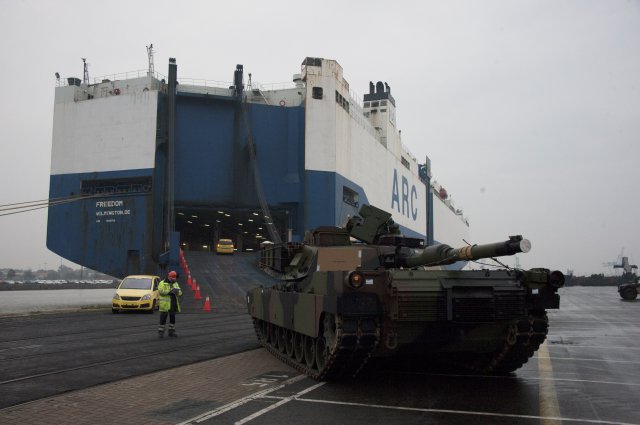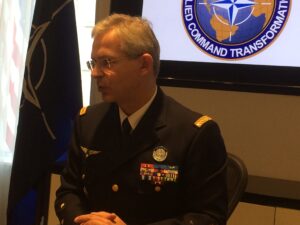Hey Putin, NATO Can Adapt: Trident Juncture 2015
Posted on

A US Army M1 tank about to be shipped out for the Trident Juncture wargames.
WASHINGTON: 35,000 NATO and partner-nation troops. 140 aircraft. 60 naval vessels. 30 nations. But who are they fighting?
When planning began two years ago for NATO’s largest wargames since 2002, the imaginary adversary wasn’t Russia. Officially, it still isn’t. But since the seizure of Crimea, the alliance’s chief of “transformation” told reporters today, planners have added new challenges to the standard scenario that sound awfully relevant to the Russian threat, from ballistic missile defense to rapid deployment to hybrid war.
If the original message of the Trident Juncture 2015 exercises was “NATO can still go big,” the message of the modified Trident Juncture might be, “Hey, NATO can adapt.”

Gen. Denis Mercier
“We had to adapt the scenario [to] integrate all the main challenges we are facing now,” French Air Force Gen. Denis Mercier, Supreme Allied Commander for Transformation, said in a roundtable with reporters here this morning. Compared to 13 years ago, the world is changing at a faster past, he said: “The threats and surprises have accelerated, so we have to be sure that we are flexible enough to integrate in our exercises these new concepts and to speed up the processes of developing new ideas.”
In contrast to the last large exercise in 2002, Mercier said, Trident Juncture puts much more emphasis on testing out new ideas, in addition to training troops.
Trident Juncture started with a scenario called SOROTAN, which simulates a response to an “out of area” crisis — that is, one in which NATO members’ territory is not directly at risk. (So like Ukraine, but unlike the Baltics.) But planners kept adding elements. After last year’s alliance summit in Wales created a new Very High Readiness Joint Task Force, for instance, rapid deployment of a “spearhead force” became part of the exercise, Gen. Mercier said.
The simulated adversary also evolved into what’s called a hybrid threat, Mercier said: a nation-state not only deploying regular forces — including tanks and anti-aircraft missiles — to menace its neighbors, but also employing guerrilla fighters as proxies. That sounds a lot like Ukraine but Russia is hardly the only nation to take such an approach: Iran is another prime example.
The adversary even poses a cyber and electronic warfare threat, hacking and jamming NATO systems — to a limited extent. “It probably won’t go until the moment where we have to shut down,” Mercier said. “We’ll have events and see how the players can react to… disruptions of some of the networks. I don’t think that we’ll go to the point where the full network will be absolutely disrupted.”
That’s not actually an unreasonable restraint, given how hard it is to get multi-national, multi-military networks to work at all. NATO developed a fairly smoothly functioning system in Afghanistan, but only after years of dedicated effort.
“The lessons-learned from Afghanistan showed us that, from the very beginning, if you want to have this full interoperability, you have to be build what we call a federated mission network…that will enable all the national communications to be able work together,” Mercier said. A big part of Trident Juncture is simply showing that NATO can make this function.
The first phase of Trident Juncture, in fact, is played entirely over networks between headquarters — a “command post exercise” — without troops on the ground at all. The live portion of the exercise only begins next week, but it’s crucial, the general emphasized.
“You can imagine, when you have a computer-assisted exercise, that you deploy your forces wherever,” Mercier said. When you actually have to move real troops over real terrain — and often across real international borders — you run into a lot of messy logistical and even legal issues that you really want to figure out before there’s a crisis, he said. “The reality is in the details.”
Subscribe to our newsletter
Promotions, new products and sales. Directly to your inbox.
